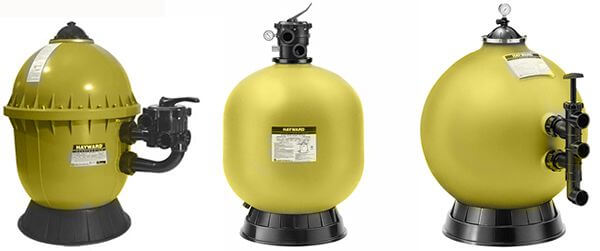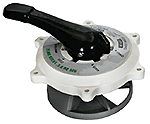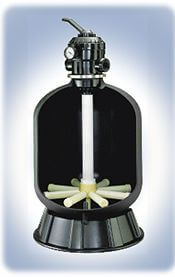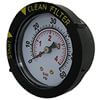How To Remove +stuck Standpipe From The Valve Of A Sand Filter

Your swimming puddle filter is ane half of the nigh important equipment needed to go on your water looking fresh and clean. You want pool water that sparkles, which means the filter needs to be kept in optimum working condition. As with the pool pump, pool filter problems need to be fixed quickly, to forestall algae growth.
Today nosotros look at some common Sand Pool Filter Problems to watch for, and how to gear up your own sand filter trouble, with just basic paw tools, and in some cases a few sand filter parts.
1. H2o LEAKING OUT OF WASTE LINE
A filter's Multiport Valve is a complex slice of the filter so keeping an middle on it throughout the season is to your reward. There are over a dozen parts inside a multiport valve, and multiple ports for the h2o to menses, hence the name.Button-pull valves, mounted on the side of a sand filter, are simpler, with just two ports for filtering or backwashing.
After you finish backwashing it is not unusual to discover a piffling stream of water continuing to come out the backwash line. Jiggle the handle, and if in that location's yet h2o coming out minutes later that signifies a problem with the valve. The majority of the time leaks such every bit this are from a bad spider gasket on a multiport valve, or plunger o-rings on a push-pull valve. A spider gasket seals up the ports (including the waste h2o port) to control the direction of your puddle water.
Through normal use the gasket rubber will wearable down and eventually allow water or debris to bypass the intended direction and escape out the backwash port, or return to the puddle unfiltered. Turning the valve while the filter is running can also disrupt the seal. it is worth noting that sometimes the gasket merely needs to be cleaned upwardly, reset and lubed.
 To inspect or repair a leaking multiport valve, plow off power to your pump and release the pressure in the filter, then remove the screws on top of the valve. Now you can lift out the embrace, handle and key stem all in one piece (this is called the key stem assembly). The spider gasket volition be sitting inside the body of the valve. Clean information technology off and check for whatever tears or twisting, or other signs of damage. It can be replaced by lifting out the old gasket with a small, sharp screwdriver, and then gluing in the exact replacement spider gasket (flat side down, ridged side upwardly).
To inspect or repair a leaking multiport valve, plow off power to your pump and release the pressure in the filter, then remove the screws on top of the valve. Now you can lift out the embrace, handle and key stem all in one piece (this is called the key stem assembly). The spider gasket volition be sitting inside the body of the valve. Clean information technology off and check for whatever tears or twisting, or other signs of damage. It can be replaced by lifting out the old gasket with a small, sharp screwdriver, and then gluing in the exact replacement spider gasket (flat side down, ridged side upwardly).
 On some valves, similar the Hayward SP714T, the spider gasket is glued into the bottom of the diverter, rather than inside grooves of the valve trunk. Leaking out the backwash line on this type of valve is more likely to be broken spring on the diverter stem, or debris stuck within of the valve.
On some valves, similar the Hayward SP714T, the spider gasket is glued into the bottom of the diverter, rather than inside grooves of the valve trunk. Leaking out the backwash line on this type of valve is more likely to be broken spring on the diverter stem, or debris stuck within of the valve.
ii. DIRT COMING BACK INTO THE Pool
Sand filters can pass some pocket-size droppings back into the pool, and it can be considered normal, particularly if you are vacuuming fine, silty dirt. You may come across a stream coming back in through the render lines, during vacuuming, or right after backwashing. Vacuuming to waste matter volition fix the former, and using the Rinse setting afterward backwashing volition fix the latter.
There are other means to improve the effectiveness of sand filters, such every bit using a Pool Clarifier to improve h2o clarity with a sand filter, and using a Sand Filter Cleaner regularly to refresh the sand and remove oils and scale (and clarifier!). The Slime Bag is a mesh pocketbook that you adhere to your return line wall fitting, that acts equally a secondary filter to trap very tiny particles.
- Worn-Out Sand. Over time the precipitous edges wear downward, and dirt belongings chapters goes downwardly.
- Calcified Sand. Very hard water minerals tin turn filter sand into kind of a sandstone.
- Mudballing. Oils collect in a sand tank, making gooey balls of gunk in the top third of the sand.
- Channelling. If the pump is as well powerful for the filter, it can forcefulness water through unfiltered.
- Bypassing. The filter valve could exist bypassing dirt, from a too powerful pump, or bad spider gasket or valve spring.
3. Broken MULTIPORT HANDLE
Using too much force, or big tree branches can break the handle on top of a multiport valve. If the handle has a lot of move in it, or is existent floppy, yous may have to replace the bound within the key stem assembly. In this example, it may be improve to supervene upon the key assembly; it's definitely a lot easier.
To replace but the handle, remove the fundamental stem assembly as described above, and identify it on a soft surface where yous tin can apply pressure to the top encompass (compressing the bound) and remove the pin that runs through the handle by borer information technology out. One time the handle is off, check the large nylon washers that lie underneath it within the middle of the tiptop embrace; it tin crack over time and this too can disrupt proper handle function. There are too o-rings on the stem that goes through the lid. Make clean and/or replace whatsoever valve parts that need replacement, then put back information technology all back together, being careful to replace the lid in the exact same orientation over the diverter, so that everything lines up correctly.
4. LEAKY FILTER TANK
This one'southward even easier…it is not condom to repair a cracked tank. You need to purchase a new 1, and it's usually cheaper to buy an entire new filter than to just buy the tank. Patching a pressure tank like a sand filter will e'er fail, and the eventual rupture could drain the pool or injure someone continuing nearby. There are other sand filter leaks that can be fixed however, with the right filter parts.
- Leaking air bleeder. Typically an o-ring or some Teflon record will seal these upward.
- Leaking drain assembly. The drain plug or cap tin lose an o-ring or gasket.
- Leaking flange assembly. Top mount valves seal upward to the tank with an o-ring and a tight clamp.
- Leaking bulkheads. Side mount valves have bulkheads on the tank with many spacers and gaskets.
- Leaks where the pipes connect into valve. Cracks from over-tight fittings.
SAND IN THE POOL?
 Broken Laterals? If your sand filter is leaking sand, into the puddle, constantly (non just after backwashing), this is commonly a broken lateral. Laterals are plastic parts at the lesser of the sand filter, with slits so pocket-size that it keeps out sand grains, until information technology cracks that is. Information technology could also be a broken standpipe or diffuser – all internal parts that crack can leak sand into the pool.
Broken Laterals? If your sand filter is leaking sand, into the puddle, constantly (non just after backwashing), this is commonly a broken lateral. Laterals are plastic parts at the lesser of the sand filter, with slits so pocket-size that it keeps out sand grains, until information technology cracks that is. Information technology could also be a broken standpipe or diffuser – all internal parts that crack can leak sand into the pool.
You may come across a short deject of dusty sand correct after backwashing, but when a lateral bursts, you volition know it. Several handfuls of sand or fifty-fifty much more will exist on the floor below the returns.
The solution? Bleed the tank, scoop out the sand, and replace the entire set of laterals. Y'all can reuse the filter sand if it's yet in good shape. Generally, pool filter sand lasts near 5-7 years before it wears out and needs to be replaced (except for very small filters used on aboveground pools, which usually need new sand much sooner.
5. HIGH FILTER Force per unit area
A sand filter needs backwashing when the pressure level gauge reads eight-10 lbs higher than the pressure afterward cleaning. When you backwash, h2o goes through the filter tank backwards, hence the name. Backwashing for iii-5 minutes flushes out the dirt from the sand bed and out the waste line or hose. 
"Normal" sand filter pressure? Something around 10 psi isusual, merely information technology depends on the pump size, pipage size and resistance from the other equipment that you have. Every puddle has different arrangement pressure estimate readings, a normal filter force per unit area could be annihilation from 5-25 psi. "High" filter pressure is annihilation above 30 psi.
The rule of thumb is that if pressure is college than normal it's a dirty filter, and if information technology'south lower than normal, it's a dirty pump basket (or impeller). But what is happening when you backwash the filter and the pressure level judge remains loftier? Here's some things to check.
- Bad Sand, or oily, gunky sand. Replace sand or apply sand filter cleaner.
- Bad estimate. Does information technology go to zero when the pump shuts off? It could be stuck.
- Obstacle after the filter. Partially closed valve, plugged or clogged lines.
- Obstacle before the filter. Poor water flow into the filter.
- Multiport valve recirculating water, reducing backwash water flow.
Sand puddle filter repairs are Urgent , you've got to get the water filtering again fast. If you tin't filter the water while pending sand filter parts, you may exist able to at least circulate the water, by using the filter bypass setting, Recirculate. Go along the chlorine level high by adding granular pool shock, and brush and skim the pool daily until you can brand the filter repair.
Give united states a call if you want to hash out your sand filter problems – enquire for me, or any of the other ITS Pool Experts!
How To Remove +stuck Standpipe From The Valve Of A Sand Filter,
Source: https://blog.intheswim.com/top-5-swimming-pool-sand-filter-problems/
Posted by: murphyroyshe.blogspot.com


0 Response to "How To Remove +stuck Standpipe From The Valve Of A Sand Filter"
Post a Comment